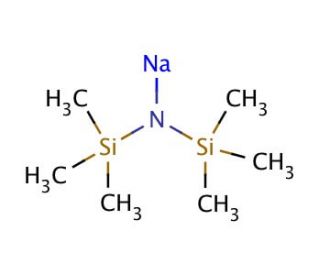

Sodium bis(trimethylsilyl)amide (CAS 1070-89-9)
QUICK LINKS
Sodium bis(trimethylsilyl)amide serves as a strong, non-nucleophilic base in various synthetic organic chemistry applications. Its mechanism of action primarily involves the abstraction of protons from a wide range of acidic hydrogen atoms, making it indispensable in the formation of carbon-nitrogen bonds and the deprotonation of weakly acidic compounds. This characteristic enables its use in the promotion of various organic reactions, including anionic polymerization processes and the synthesis of heterocyclic compounds. In research applications, Sodium bis(trimethylsilyl)amide′s robustness and selectivity facilitate the exploration of complex synthetic pathways, allowing for the efficient construction of molecules that are of interest in the development of new materials and the study of organic reaction mechanisms. Its role extends to the activation of substrates for nucleophilic addition reactions, illustrating its versatility and essential function in advancing the frontiers of synthetic organic chemistry.
Sodium bis(trimethylsilyl)amide (CAS 1070-89-9) References
- A concise enantioselective entry to the synthesis of deoxy-azasugars. | Martín, R., et al. 2000. Org Lett. 2: 93-5. PMID: 10814254
- Structural studies of N,N'-di(ortho-fluorophenyl)formamidine group 1 metallation. | Cole, ML., et al. 2003. Chemistry. 9: 415-24. PMID: 12532290
- 1,2-Eliminations in a novel reductive coupling of nitroarenes to give azoxy arenes by sodium bis(trimethylsilyl)amide. | Hwu, JR., et al. 2005. Org Lett. 7: 3211-4. PMID: 16018623
- Synthesis and structural characterisation of lithium and sodium 2,6-dibenzylphenolate complexes. | Cole, ML., et al. 2006. Dalton Trans. 3338-49. PMID: 16820846
- Efficient nucleophilic aromatic substitution between aryl nitrofluorides and alkynes. | DeRoy, PL., et al. 2007. Org Lett. 9: 2741-3. PMID: 17552534
- Synthetic and Structural Studies of Mixed Sodium Bis(trimethylsilyl)amide/Sodium Halide Aggregates in the Presence of η(2)-N,N-, η(3)-N,N,N/N,O,N-, and η(4)-N,N,N,N-Donor Ligands. | Ojeda-Amador, AI., et al. 2015. Inorg Chem. 54: 9833-44. PMID: 26417943
- Revealing the reduction process of Cu(ii) by sodium bis(trimethylsilyl)amide. | Yang, D., et al. 2019. Faraday Discuss. 220: 105-112. PMID: 31532426
- Synthesis and biological activity of new diarylalkenes. | Gołebiewski, WM., et al. 1999. Pharmazie. 54: 26-30. PMID: 9987795
Ordering Information
| Product Name | Catalog # | UNIT | Price | Qty | FAVORITES | |
Sodium bis(trimethylsilyl)amide, 5 g | sc-258162 | 5 g | $71.00 | |||
Sodium bis(trimethylsilyl)amide, 25 g | sc-258162A | 25 g | $206.00 |
